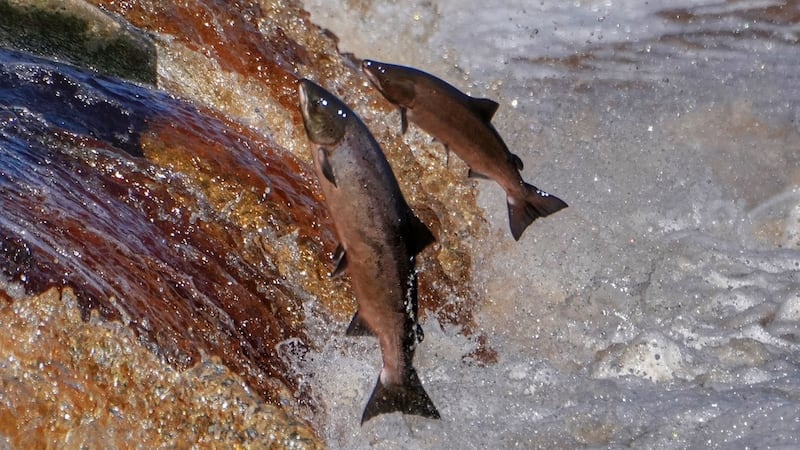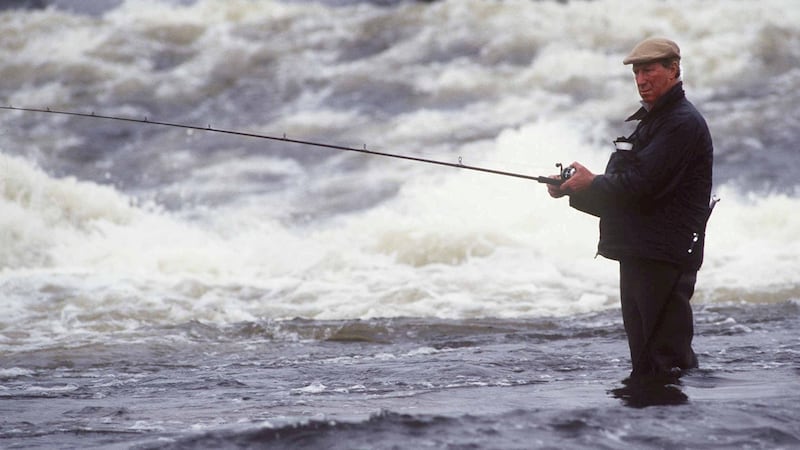Fishing is not widely regarded as a spectator sport these days. But there’s a stretch of the Moy river in Ballina, Co Mayo, known as the ridge pool, where local man Pappy Forde can remember hundreds of people regularly lining up on each side to follow the “great battle” between angler and hooked fish, which could last for half an hour.
“If they caught the fish, the audience would cheer. It would be like a football match,” says Forde, himself a keen fishermen who has also acted as a ghillie (expert guide) for visiting anglers over many decades.
“They would see the salmon leaping up and down for 20 minutes, and the runs the salmon would take – and then they would see John releasing the fish – and they’d all be screaming.”
John Howley, employed as a ghillie by the State-owned Moy fishery since the early 1990s, chuckles as he recalls onlookers often being baffled at the sight of the salmon being returned to the water after such thrilling contests between fish and angler, who would often be standing in water up to chest level.
RM Block
But even then Howley, who Moy fishery manager Barry Kelly says “knows every stone in that river”, and the other staff, were encouraging conservation among their clients.
In 1996, Howley says, more than 5,000 fish were caught on the rod in the ridge pool, in a town known as “the salmon capital of Ireland”. It was an era when the river was alive with fish, charging like silver bullets upstream to the very river beds where they were spawned, having wintered in the North Atlantic.
Over the past five years the salmon rod catch in the Moy estuary, which includes a number of key town centre stretches as well as the ridge pool, has varied between 196 and 488, a dramatic decline even when factoring in the impact of the Covid-19 pandemic. The downward trend has been persistent with 2,903 salmon caught in 2006, falling to 1,943 in 2010 at a fishing destination beloved by the late former Republic of Ireland football manager Jack Charlton and many others.
These figures in relation to the Moy reflect what Inland Fisheries Ireland (IFI) deputy chief executive Dr Cathal Gallagher recently described as “a catastrophic collapse” in the numbers of salmon in Ireland’s rivers and lakes. While its numbers are stark, the Moy is faring better than many waterways.
Dr Gallagher told the Oireachtas Public Accounts Committee that wild salmon numbers returning to Ireland had dropped from 1.76 million in 1975 to just 171,700 in 2022, a decline of more than 90 per cent.
Forde, who in the past acted as ghillie for Emlyn Hughes, the former England and Liverpool captain, remembers years when he caught up to 100 salmon “but you’d only keep what you’d need for the table”. Last year he caught three.
Declan Cooke was manager of the Moy fishery for two decades until 2020. Over that time saw the numbers drop from up to 3,000 salmon in the good years to just a few hundred more recently.
Now tasked with heading up the IFI’s habitat specialisation unit, which has the brief of restoring river habitats cleared out during major drainage schemes in the 1960s, he agrees that “nationally the picture is pretty grim”.

“It is no one thing but our biggest concern at the moment is marine survival,” he says. Juvenile salmon leave the Irish rivers where they were spawned in April or May, going out to sea as maybe 15cm fish to spend one to three years feeding in the North Atlantic.
“Back in the 1970s out of every 100 salmon that would leave our coast, perhaps 20 to 25 would return as adults,” Cooke says. “That number is down to about four or five and that is the primary concern, and unfortunately there is very little we can do about it.”
The consensus appears to be that climate change is a driver, with fish unable to find their usual sources of food as water temperatures change.
Once the salmon are outside a 12-mile limit, IFI has no jurisdiction over them and no protective function. But they do have a series of remedial measures in train where they do have jurisdiction. These include tackling the 73,377 potential barriers or man-made structures on Irish rivers which can hamper fish movements and migrations.
“It could be anything like an apron on a bridge that causes a barrier. If not blocking then significantly impeding migration so that it is possible only at certain water levels,” says Kelly. Even this temporary trapping of a large volume of fish in a pool downstream can lead to protection issues, making the salmon very vulnerable to poachers.
“These would be adult fish weighing anything from three to 12 or 13 pounds,” Kelly adds.
Poaching is not such as big an issue now as in the past, according to IFI officials, but it has not gone away.
IFI secured convictions at Sligo District Court last month in four illegal salmon cases. In one, a man in a wetsuit and snorkel was observed swimming to a 100m net set offshore at Roskeeragh Point, Mullaghmore, in an attempt to capture salmon.
In another, a man took a salmon from a catch-and-release river, the Garavogue in Sligo town, and placed it into a rucksack before attempting to leave on a bicycle. Separately, two men were convicted of not having a licence or permit to fish at Ballisodare fishery.
Pollution and restoration of river habitats continue to preoccupy IFI staff. Cooke says a lot of gravel and stone, which salmon need to spawn and to hide, was removed during big drainage works in an attempt to improve agricultural land. He and his colleagues are trying to recreate these habitats “in a pattern we hope is reflective of nature”.
With the 60th Ballina Salmon Festival scheduled to take place this summer, the fish continues to have a special place in the culture and economy of the town and locals hope it stays that way.
Forde reckons that Ballina people are concerned that, should the crisis deepen, conservation measures might call a halt to fishing temporarily in order to let the stocks rebuild.
This year 48 Irish rivers are fully open for salmon fishing and 33 are running on a “catch and release” basis. But 66 rivers remain closed to fishing as they do not have the necessary “surplus” to ensure salmon stocks survive.
“Everyone wants to be here when the summer salmon grilse [mature salmon] are running,” says Kelly.
He introduced a conservation measure last year on Moy fishery beats – including the ridge pool, cathedral beat, weir pool and a few other popular spots – restricting anglers to two salmon a day from May 12th to August 31st, down on the legal national limit of three during this period.
Howley says the flow of international and national visitors attracted by the salmon is equivalent to having a couple of factories in the town but it is about much more than the business created for local hotels, restaurants and bars.
“It is like a pilgrimage,” says Kelly of the regulars who return year in year out.
“It is like an addiction,” adds Howley, who started to fish as a child and was taught by a Scottish angler how to fly fish, which the experts regard as fishing in its purest form.

He was fishing with the late Jack Charlton back when the then Irish manager created a spectacle for hundreds of spectators who watched him from the river bank, when his salmon literally got caught between a rock and a hard place.
“It went down behind a rock. I had to bring him across the river in a boat. He was standing up, it would not be allowed now, but we managed to get the fish out.”
“Tiger Woods has also caught salmon here‚” adds Howley, who has also acted as ghillie for actors James Caan and Liam Neeson and golfer Mark O’Meara.
He strikes an optimistic note as he points out that anglers and salmon still come to the Moy, albeit in lower numbers.
“They are working on the spawning beds and if they repair them it will help big time.”
- Sign up for push alerts and have the best news, analysis and comment delivered directly to your phone
- Find The Irish Times on WhatsApp and stay up to date
- Listen to our Inside Politics podcast for the best political chat and analysis















